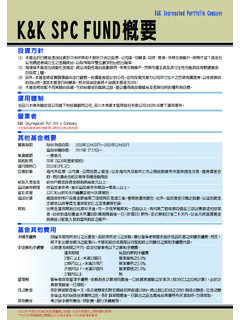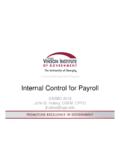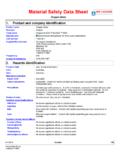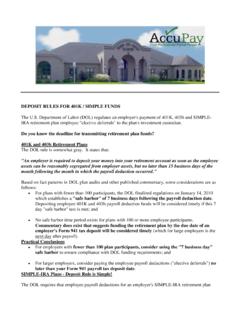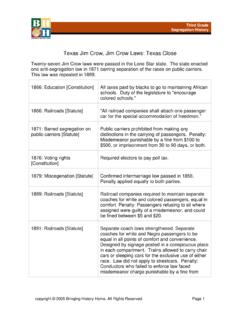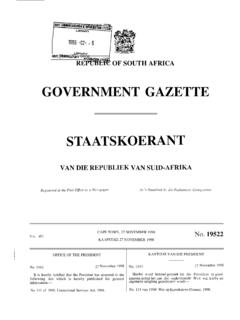Transcription of INTRODUCTION I. THE POPULIST CHALLENGE II. …
1 OUTLINE Chapter 17 Freedom s Boundaries, at Home and Abroad, 1890-1900 This chapter examines debates about the boundaries of freedom during the final decade of the nineteenth century. These debates revolved around the role of laborers, farmers and African Americans in the new urban, industrial society. The chapter also examines how America s rise in world power prompted discussions about democracy and empire. INTRODUCTION I. THE POPULIST CHALLENGE II. THE SEGREGATED SOUTH III. REDRAWING THE BOUNDARIES IV. BECOMING THE WORLD INTRODUCTION STORY: In 1892 Andrew Carnegie and his partner Henry Clay Frick decided to purge union workers from their steel plant in Homestead, Pennsylvania. The Homestead steelworks was one of the largest factories in the world with nearly 4,000 employees. What followed was one of the worst labor confrontations in American history. The Homestead strike symbolized two contesting views about freedom during the late nineteenth century.
2 Rarely has the country experienced at one time so many debates over both the meaning of freedom and freedom s boundaries, according to Eric Foner. THEMES: 1. Farmers in the Midwest and South protested the centralization of economic power that accompanied industrialization. Although the Populists did not succeed in achieving all their goals, their efforts laid the groundwork for future reform movements. 2. Segregation of the races, which had been informal practice in the South since the Civil War, became formal law for the nation as a whole. Constitutional segregation prevailed until the in50s. 3. As American economic power grew, the nation undertook a program of overseas expansion which raised new issues about the meaning of freedom and who should enjoy its benefits. I. THE POPULIST CHALLENGE FOCUS QUESTION: What were the sources and significance of Populism? A. The Farmers Revolt 1. Farmers faced increasing economic insecurity 2.
3 Farmers sought to improve their condition through the Farmers Alliance B. The People s Party 1. The People s, or POPULIST , Party emerged from the Farmers Alliance in the 1890s a. Spoke for all the producing classes 2. The Populists embarked on a remarkable effort of community organization and education 3. The POPULIST platform of 1892 remains a classic document of American reform 4. Populists sought to rethink the relationship between freedom and government to address the crisis of the 1890s C. The POPULIST Coalition 1. The Populists made remarkable efforts to unite black and white small farmers on a common political and economic program a. Colored Farmers Alliance ID & S POPULIST Party STUDY HINT You should be able to identify the key complaints of the Populists and the key reforms they proposed. 2. While many blacks refused to abandon Lincoln s party others were attracted by the POPULIST appeal 3.
4 The POPULIST movement also engaged the energies of thousands of reform-minded women from farm and labor backgrounds a. Mary Elizabeth Lease 4. 1892 president candidate James Weaver won over 1 million votes D. The Government and Labor 1. The severe depression that began in 1893 led to increased conflict between capital and labor a. Coxey s Army 2. Pullman strike of 1894 saw the labor leader Eugene Debs jailed E. Populism and Labor 1. Populists made determined efforts to appeal to industrial workers but ultimately failed to get labor s support 2. Instead of to the Populists, working-class voters in 1894 shifted en masse to the Republicans F. Bryan and Free Silver 1. In 1896, Democrats and Populists joined to support William Jennings Bryan for the presidency ID & S Eugene V. Debs ID & S William Jennings Bryan a. Called for free silver b. Condemned the gold standard G. The Campaign of 1896 1.
5 Republicans nominated Ohio governor William McKinley 2. The election of 1896 is sometimes called the first modern presidential campaign a. Mark Hanna 3. Some view L. Frank Baum s The Wonderful Wizard of Oz as a commentary on the election of 1896 and its aftermath 4. McKinley s victory shattered the political stalemate that had persisted since 1876 and created one of the most enduring political majorities in American history STUDY HINT You should be able to describe the issues in the 1896 Presidential election and know its outcome. II. THE SEGEGATED SOUTH FOCUS QUESTION: How was a system of racial segregation established in the South? A. The Redeemers in Power 1. On achieving power, Redeemers had moved to undo as much of Reconstruction as possible a. Public school systems hardest hit 2. New laws authorized the arrest of virtually any person without employment and greatly increased the penalties for petty crimes B.
6 The Failure of the New South Dream 1. The region as a whole sank into deeper economic trouble. C. Black Life in the South 1. As the most disadvantaged rural southerners, black farmers suffered the most from the region s condition a. Blacks owned less land in 1900 than they had at the end of Reconstruction 2. Cities supported the growth of a black middle class 3. Most unions excluded blacks D. The Kansas Exodus ID & S Redeemers STUDY HINT You should be able to describe black life in the South during this time period. 1. African-Americans migrated to Kansas, seeking political equality, freedom from violence, access to education, and economic opportunity 2. Most African-Americans had little alternative but to stay in the South a. Most northern employers refused to offer jobs to blacks E. The Decline of Black Politics 1. Political opportunities became more and more restricted 2. The banner of political leadership passed to black women activists a.
7 The National Association of Colored Women F. The Elimination of Black Voting 1. Some states saw coalitions between black Republicans and anti-Redeemer Democrats 2. Between 1890 and 1906, every southern state enacted laws or constitutional provisions meant to eliminate the black vote 3. Numerous poor and illiterate whites also lost the right to vote 4. The elimination of black and many white voters could not have been accomplished without the approval of the North STUDY HINT You should be able to describe how blacks were denied the right to vote despite the protections of the Constitution. G. The Law of Segregation 1. In 1896, in the landmark Plessy v. Ferguson decision, the Supreme Court gave its approval to state laws requiring separate facilities for blacks and whites 2. John Marshall Harlan was the lone dissenter on the Supreme Court H. The Segregated South 1. States reacted to the Plessy decision by passing laws mandating racial segregation in every aspect of southern life a.
8 No black high school existed in the South by 1900 2. The point was not so much to keep the races apart as to ensure that when they came into contact with each other whites held the upper hand I. The Rise of Lynching 1. Those blacks who sought to CHALLENGE the system, or who refused to accept the demeaning behavior that was a daily feature of southern life, faced violence 2. Many white southerners considered preserving the purity of white womanhood a justification of extralegal vengeance a. The charge of rape was a bare lie ID & S Plessy v. Ferguson III. REDRAWING THE BOUNDARIES FOCUS QUESTION: In what ways did the boundaries of American freedom grow narrower in this period? A. The New Immigration and the New Nativism 1. million immigrants, mostly from southern and eastern Europe, arrived in the 1890s a. Viewed as inferior by native-born Americans b. Various suggestions were made by nativists to eliminate the immigrants ability to vote B.
9 Chinese Exclusion 1. The Page Act barred Chinese women from entering the country 2. Chinese Exclusion Act of 1882 barred Chinese from the United States C. The Rights of the Chinese 1. Chinese demands for equal rights forced the Supreme Court to define the reach of the Fourteenth Amendment a. Yick Wo v. Hopkins b. United States v. Wong Kim Ark 2. Fong Yue Ting (1893) authorized the federal government to expel Chinese aliens ID & S Nativism ID & S Chinese Exclusion Act without due process of law 3. Exclusion profoundly shaped the experience of Chinese-Americans D. The Emergence of Booker T. Washington 1. Prominent black leaders took to emphasizing economic self-help and individual advancement into the middle class as an alternative to political agitation 2. Washington emphasized vocational education over political equality 3. He urged blacks not to try to combat segregation E. The Rise of the American Federation of Labor (AFL) 1.
10 The rise of the AFL reflected a shift away from a broadly reformist past to more limited goals 2. Samuel Gompers pioneered business unionism 3. In the 1890s, the labor movement became less and less inclusive F. The Woman s Era 1. Changes in the women s movement reflected the same combination of expanding activities and narrowing boundaries 2. Through a network of women s clubs, temperance associations, and social reform ID & S Booker T. Washington ID & S American Federation of Labor organizations, women exerted a growing influence on public affairs a. Women s Christian Temperance Union (WCTU) 3. The center of gravity of feminism shifted toward an outlook more in keeping with prevailing racial and ethnic norms IV. BECOMING A WORLD POWER FOCUS QUESTION: How did the United States emerge as an imperial power in the 1890s? A. American Expansionism 1. America was a second-rate power in the 1880s 2.



